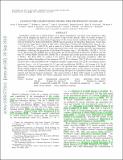Clouds in the coldest brown dwarfs: FIRE spectroscopy of Ross 458C
Author(s)
Burgasser, Adam J.; Simcoe, Robert A.; Bochanski, John J.; Saumon, Didier; Mamajek, Eric E.; Cushing, Michael C.; Marley, Mark S.; McMurtry, Craig; Pipher, Judith L.; Forrest, William J.; ... Show more Show less
DownloadSimcoe_Clouds in.pdf (1.083Mb)
OPEN_ACCESS_POLICY
Open Access Policy
Creative Commons Attribution-Noncommercial-Share Alike
Terms of use
Metadata
Show full item recordAbstract
Condensate clouds are a salient feature of L dwarf atmospheres, but have been assumed to play little role in shaping the spectra of the coldest T-type brown dwarfs. Here we report evidence of condensate opacity in the near-infrared spectrum of the brown dwarf candidate Ross 458C, obtained with the Folded-Port Infrared Echellette (FIRE) spectrograph at the Magellan Telescopes. These data verify the low-temperature nature of this source, indicating a T8 spectral classification, log[subscript 10] L bol/L[subscript ☉] = –5.62 ± 0.03, T [subscript eff] = 650 ± 25 K, and a mass at or below the deuterium burning limit. The data also reveal enhanced emission at the K band associated with youth (low surface gravity) and supersolar metallicity, reflecting the properties of the Ross 458 system (age = 150-800 Myr, [Fe/H] = +0.2 to +0.3). We present fits of FIRE data for Ross 458C, the T9 dwarf ULAS J133553.45+113005.2, and the blue T7.5 dwarf SDSS J141624.08+134826.7B, to cloudless and cloudy spectral models from Saumon & Marley. For Ross 458C, we confirm a low surface gravity and supersolar metallicity, while the temperature differs depending on the presence (635[superscript +25] [subscript –35] K) or absence (760[superscript +70] [subscript –45] K) of cloud extinction. ULAS J1335+1130 and SDSS J1416+1348B have similar temperatures (595[superscript +25] [subscript –45] K), but distinct surface gravities (log g = 4.0-4.5 cgs versus 5.0-5.5 cgs) and metallicities ([M/H] ≈ +0.2 versus –0.2). In all three cases, cloudy models provide better fits to the spectral data, significantly so for Ross 458C. These results indicate that clouds are an important opacity source in the spectra of young cold T dwarfs and should be considered when characterizing planetary-mass objects in young clusters and directly imaged exoplanets. The characteristics of Ross 458C suggest that it could itself be regarded as a planet, albeit one whose cosmogony does not conform with current planet formation theories.
Date issued
2010-11Department
Massachusetts Institute of Technology. Department of Physics; MIT Kavli Institute for Astrophysics and Space ResearchJournal
Astrophysical Journal
Publisher
IOP Publishing
Citation
Burgasser, Adam J. et al. “Clouds in the coldest brown dwarfs: FIRE spectroscopy of Ross 458C.” The Astrophysical Journal 725.2 (2010): 1405–1420.
Version: Author's final manuscript
ISSN
0004-637X
1538-4357